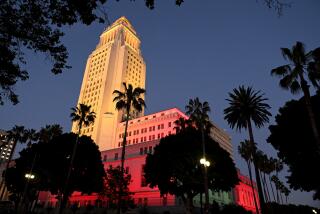Learning How to Get Things Done at City Hall : Government: The aim of the Manhattan Beach program is to develop informed community leaders by teaching them the inner workings of municipal agencies.
- Share via
Ever wonder what it’s like to be fingerprinted, booked and locked up in the city jail? Or how they paint those pedestrian crosswalks on the street? Or how the school system spends its money?
If you were a graduate of one of Manhattan Beach’s leadership classes, you’d know--along with countless other bits of trivia about the working of city agencies, nonprofit organizations and economic councils within the city and around the South Bay.
Sponsored by the Manhattan Beach Chamber of Commerce, the course is in its second year and is one of more than 600 such programs across the country. Its goal is to develop a network of potential community leaders within the city who are not only interested in improving their community, but also schooled in the best way to get things done there, program Chairman Paul Allman said.
Members attend five- to six-hour seminars monthly for nine months. Each covers a specific topic, such as education, economics or the environment, and as many as a dozen speakers present information at the sessions. Speakers include private consultants and representatives from city agencies, businesses, nonprofit organizations and special interest groups.
Members are also required to complete a community service project by the end of the course. For last year’s class, Leadership ‘92, this was a public education program designed to raise awareness about the city’s storm drains and their impact on pollution levels in Santa Monica Bay.
“By the time they’ve gone through the nine-month program, they’ll understand what it’s like to be a community leader,” Allman said. “The frustration of organizing a group of people you have no real control over, implementing a community project, with all the headaches and the bureaucracies that (you have to deal with), and doing it in a (specific) time frame.”
Each class is limited to 20 people, at a cost of $450 to participants, although some scholarship funds are available. Corporate sponsors such as Chevron, Hughes Aircraft and TRW actually provide most of the funds for the program.
Although the only real requirement is an interest and willingness to be involved in community service, many class members are already influential players in the city, such as Nikki Harris, 47, a commercial bank loan officer and 17-year veteran volunteer with the League of Women Voters.
“Being involved with the league, I (already) knew a lot about city government, the administrative aspects . . . (but now) I have become a better resource for the people I work with,” Harris said. “When we wanted to have a ballot measure talk in Manhattan Beach, I knew who to call at the City Hall to ask, ‘Can we use the City Council chambers?’
“(I had) names to call when the league needed money . . . to support a candidates night. I knew the public affairs officer at Chevron and TRW and Hughes . . . and all because of my class.”
Other students gained a new perspective on some of the city’s departments. For Linda Green, an interior design consultant and a longtime environmental activist, the opportunity to ride with police officers and view their day-to-day operations was an eye-opener, she said.
“A lot of people have a negative perception of the Police Department. It helped to see the human side of them,” she said.
Some of the information was described by class members as sobering, particularly the presentations on environmental problems and education. Investment brokerage manager Paul Blieden, 50, said he was surprised to learn that “a lot of the programs presented within the schools in Manhattan Beach come from funding (sources) outside of the school system . . . an education foundation that raises money. There’s a major shortfall in what tax revenues provide to the school system, and a lot of school systems are cutting many, many programs that I grew up with and took for granted.”
Not all the sessions were all business, however. Homemaker and self-described dilettante Lynn Summers, 57, said she most enjoyed the session “where we visited the police and fire departments and got to play with all their equipment. I’ve been in the police station a million times but I had never gone and seen the jail and the whole workings of the police station. It was entertaining, it was certainly worthwhile, and how gracious all the people were to us!”
The current class runs through May. Active recruiting for the class of ’94 will begin in April, although anyone interested may apply at any time.
“It’s not just to train leaders who will become part of the City Council or the infrastructure of the community, but rather to (bring together) people who want to have an impact, who want to participate,” Allman said. “Instead of that ongoing, pervasive frustration when they see something that needs doing (and) . . . they’re overwhelmed with how they can even make an impact, this way you have 20 people in the community now, maybe 100 people in five years . . . who can say, ‘Well, you need to talk to this person.’ ”
And for those who are wondering how they paint those crosswalks? The Public Works Department uses street-size stencils.
More to Read
Sign up for Essential California
The most important California stories and recommendations in your inbox every morning.
You may occasionally receive promotional content from the Los Angeles Times.





![Vista, California-Apri 2, 2025-Hours after undergoing dental surgery a 9-year-old girl was found unresponsive in her home, officials are investigating what caused her death. On March 18, Silvanna Moreno was placed under anesthesia for a dental surgery at Dreamtime Dentistry, a dental facility that "strive[s] to be the premier office for sedation dentistry in Vitsa, CA. (Google Maps)](https://ca-times.brightspotcdn.com/dims4/default/07a58b2/2147483647/strip/true/crop/2016x1344+29+0/resize/840x560!/quality/75/?url=https%3A%2F%2Fcalifornia-times-brightspot.s3.amazonaws.com%2F78%2Ffd%2F9bbf9b62489fa209f9c67df2e472%2Fla-me-dreamtime-dentist-01.jpg)







